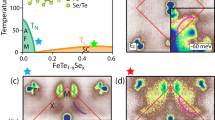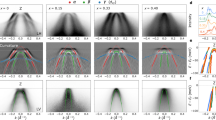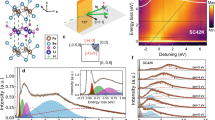Abstract
Strong electronic correlations, emerging from the parent Mott insulator phase, are key to copper-based high-temperature superconductivity. By contrast, the parent phase of an iron-based high-temperature superconductor is never a correlated insulator. However, this distinction may be deceptive because Fe has five actived d orbitals while Cu has only one. In theory, such orbital multiplicity can generate a Hund’s metal state, in which alignment of the Fe spins suppresses inter-orbital fluctuations, producing orbitally selective strong correlations. The spectral weights Zm of quasiparticles associated with different Fe orbitals m should then be radically different. Here we use quasiparticle scattering interference resolved by orbital content to explore these predictions in FeSe. Signatures of strong, orbitally selective differences of quasiparticle Zm appear on all detectable bands over a wide energy range. Further, the quasiparticle interference amplitudes reveal that \(Z_{xy} < Z_{xz} \ll Z_{yz}\), consistent with earlier orbital-selective Cooper pairing studies. Thus, orbital-selective strong correlations dominate the parent state of iron-based high-temperature superconductivity in FeSe.
This is a preview of subscription content, access via your institution
Access options
Access Nature and 54 other Nature Portfolio journals
Get Nature+, our best-value online-access subscription
$29.99 / 30 days
cancel any time
Subscribe to this journal
Receive 12 print issues and online access
$259.00 per year
only $21.58 per issue
Buy this article
- Purchase on Springer Link
- Instant access to full article PDF
Prices may be subject to local taxes which are calculated during checkout





Similar content being viewed by others
References
Dagotto, E. Correlated electrons in high-temperature superconductors. Rev. Mod. Phys. 66, 763 (1994).
Georges, A., Kotliar, G., Krauth, W. & Rozenberg, M. J. Dynamical mean-field theory of strongly correlated fermion systems and the limit of infinite dimensions. Rev. Mod. Phys. 68, 13 (1996).
Paglione, J. & Greene, R. L. High-temperature superconductivity in iron-based materials. Nat. Phys. 6, 645–658 (2010).
Wang, F. & Lee, D. H. The electron-pairing mechanism of iron-based superconductors. Science 332, 200–204 (2011).
Haule, K. & Kotliar, G. Coherence–incoherence crossover in the normal state of iron oxypnictides and importance of Hund’s rule coupling. New J. Phys. 11, 025021 (2009).
Yin, Z. P., Haule, K. & Kotliar, G. Kinetic frustration and the nature of the magnetic and paramagnetic states in iron pnictides and iron chalcogenides. Nat. Mater. 10, 932–935 (2011).
de’ Medici, L., Mravlje, J. & Georges, A. Janus-faced influence of Hund’s rule coupling in strongly correlated materials. Phys. Rev. Lett. 107, 256401 (2011).
Lanata, N. et al. Orbital selectivity in Hund’s metals: the iron chalcogenides. Phys. Rev. B 87, 045122 (2013).
Georges, A., de’ Medici, L. & Mravlje, J. Strong correlations from Hund’s coupling. Annu. Rev. Condens. Matter Phys. 4, 137–178 (2013).
de’ Medici, L., Giovannetti, G. & Capone, M. Selective Mott physics as a key to iron superconductors. Phys. Rev. Lett. 112, 177001 (2014).
Fanfarillo, L. & Bascones, E. Electronic correlations in Hund metals. Phys. Rev. B 92, 075136 (2015).
de’ Medici, L. & Capone, M. in F. Mancini, R. Citro (eds) The Iron Pnictide Superconductors. Springer Series in Solid-State Sciences 186 (Springer, Cham, 2017).
de’ Medici, L. in The Physics of Correlated Insulators, Metals, and Superconductors (Modeling and Simulation Vol. 7) (eds Pavarini, E., Koch, E., Scalettar, R. & Martin, R.) 377–398 (Forschungszentrum Juelich, Juelich, 2017).
de’ Medici, L., Hassan, S. R., Capone, M. & Dai, X. Orbital-selective Mott transition out of band degeneracy lifting. Phys. Rev. Lett. 102, 126401 (2009).
Aichhorn, M., Biermann, S., Miyake, T., Georges, A. & Imada, M. Theoretical evidence for strong correlations and incoherent metallic state in FeSe. Phys. Rev. B 82, 064504 (2010).
Yu, R. & Si, Q. Mott transition in multiorbital models for iron pnictides. Phys. Rev. B 84, 235115 (2011).
Yu, R., Zhu, J.-X. & Si, Q. Orbital selectivity enhanced by nematic order in FeSe. Preprint at https://arxiv.org/abs/1803.01733 (2018).
Sprau, P. O. et al. Discovery of orbital-selective Cooper pairing in FeSe. Science 357, 75–80 (2017).
Kreisel, A. et al. Orbital selective pairing and gap structures of iron-based superconductors. Phys. Rev. B 95, 174504 (2017).
Arakawa, N. & Ogata, M. Orbital-selective superconductivity and the effect of lattice distortion in iron-based superconductors. J. Phys. Soc. Jpn. 80, 074704 (2011).
Yu, R., Zhu, J. X. & Si, Q. Orbital-selective superconductivity, gap anisotropy, and spin resonance excitations in a multiorbital t-J 1-J 2 model for iron pnictides. Phys. Rev. B 89, 024509 (2014).
Yi, M., Zhang, Y., Shen, Z.-X. & Lu, D. Role of the orbital degree of freedom in iron-based superconductors. npj Quantum Mater. 2, 57 (2017).
Suzuki, Y. et al. Momentum-dependent sign inversion of orbital order in superconducting FeSe. Phys. Rev. B 92, 205117 (2015).
Watson, M. D. et al. Evidence for unidirectional nematic bond ordering in FeSe. Phys. Rev. B 94, 201107 (2016).
Watson, M. D., Haghighirad, A. A., Rhodes, L. C., Hoesch, M. & Kim, T. K. Electronic anisotropies revealed by detwinned ARPES measurements of FeSe. New J. Phys. 19, 103021 (2017).
Terashima, T. et al. Anomalous Fermi surface in FeSe seen by Shubnikov–de Haas oscillation measurements. Phys. Rev. B 90, 144517 (2014).
Watson, M. D. et al. Emergence of the nematic electronic state in FeSe. Phys. Rev. B 91, 155106 (2015).
Coldea, A. I. & Watson, M. D. The key ingredients of the electronic structure of FeSe. Annu. Rev. Condens. Matter Phys. 9, 125–146 (2018).
Capriotti, L., Scalapino, D. J. & Sedgewick, R. D. Wave-vector power spectrum of the local tunneling density of states: ripples in a d-wave sea. Phys. Rev. B 68, 014508 (2003).
Yuan, T., Figgins, J. & Morr, D. K. Hidden order transition in URu2Si2: evidence for the emergence of a coherent Anderson lattice from scanning tunneling spectroscopy. Phys. Rev. B 86, 035129 (2012).
Lee, J. et al. Heavy d-electron quasiparticle interference and real-space electronic structure of Sr3Ru2O7. Nat. Phys. 5, 800–804 (2009).
Schmidt, A. R. et al. Imaging the Fano lattice to ‘hidden order’ transition in URu2Si2. Nature 465, 570–576 (2010).
Allan, M. P. et al. Imaging Cooper pairing of heavy fermions in CeCoIn5. Nat. Phys. 9, 468–473 (2013).
Kasahara, S. et al. Field-induced superconducting phase of FeSe in the BCS–BEC cross-over. Proc. Natl Acad. Sci. USA 111, 16309 (2014).
Watashige, T. et al. Evidence for time-reversal symmetry breaking of the superconducting state near twin-boundary interfaces in FeSe revealed by scanning tunneling spectroscopy. Phys. Rev. X 5, 031022 (2015).
Acknowledgements
We are grateful to S.D. Edkins, A. Georges, M.H. Hamidian, J.E. Hoffman, G. Kotliar, E.-A. Kim, D.-H. Lee, L. de Medici, P. Phillips and J.-H. She for helpful discussions and communications. J.C.S.D. and P.C.C. acknowledge support from the Moore Foundation’s EPiQS (Emergent Phenomena in Quantum Physics) Initiative through Grant No. GBMF4544 and Grant No. GBMF4411, respectively. P.J.H. acknowledges support from DOE Grant No. DE-FG02-05ER46236. A.Kr. and B.M.A. acknowledge support from a Lundbeckfond Fellowship (Grant No. A9318). Material synthesis and detailed characterization at Ames National Laboratory was supported by the U.S. Department of Energy, Office of Basic Energy Science, Division of Materials Sciences and Engineering—Ames Laboratory is operated for the U.S. Department of Energy by Iowa State University under Contract No. DE-AC02-07CH11358; experimental studies carried out by the Center for Emergent Superconductivity, an Energy Frontier Research Center, headquartered at Brookhaven National Laboratory, were funded by the U.S. Department of Energy under Contract No. DE-2009-BNL-PM015.
Author information
Authors and Affiliations
Contributions
A.Ko., Y.X.C. and P.O.S. developed and carried out the experiments; A.E.B. and P.C.C. synthesized and characterized the samples; A.Ko., P.O.S. and A.Kr. developed and carried out analysis; A.Kr., B.M.A. and P.J.H. provided theoretical guidance; B.M.A., P.J.H. and J.C.S.D. supervised the project and wrote the paper with key contributions from A.Ko., Y.X.C., P.O.S., A.Kr, and P.J.H. The manuscript reflects the contributions and ideas of all authors.
Corresponding author
Ethics declarations
Competing interests
The authors declare no competing interests.
Additional information
Publisher’s note: Springer Nature remains neutral with regard to jurisdictional claims in published maps and institutional affiliations.
Supplementary information
Supplementary Information
Supplementary Text, Supplementary Figures 1–22, Supplementary Video Captions 1–5, Supplementary References 1–18
Supplementary Video 1
Simulation of quasiparticle interference patterns assuming a fully coherent band structure. Video shows from energy E = –25meV to E = 25 meV in 1.25 meV steps.
Supplementary Video 2
Simulation of quasiparticle interference patterns assuming orbitally selective quasiparticle weights. Video shows from energy E = –25 meV to E = 25 meV in 1.25 meV steps.
Supplementary Video 3
Measured quasiparticle interference pattern. Video shows from energy E = –25 meV to E = 25 meV in 1.25 meV steps.
Supplementary Video 4
Measured quasiparticle interference pattern in real space within –35 meV to +35 meV energy range acquired with 1 meV spacing at 4.2 K (<TC) and 10 K (>TC).
Supplementary Video 5
Video contains real space simulated and measured quasiparticle interference pattern within –25 meV to +25 meV energy range acquired with 1.25 meV spacing.
Rights and permissions
About this article
Cite this article
Kostin, A., Sprau, P.O., Kreisel, A. et al. Imaging orbital-selective quasiparticles in the Hund’s metal state of FeSe. Nature Mater 17, 869–874 (2018). https://doi.org/10.1038/s41563-018-0151-0
Received:
Accepted:
Published:
Issue Date:
DOI: https://doi.org/10.1038/s41563-018-0151-0
This article is cited by
-
Tuning orbital-selective phase transitions in a two-dimensional Hund’s correlated system
Nature Communications (2023)
-
Vertex dominated superconductivity in intercalated FeSe
npj Quantum Materials (2023)
-
Electronic nematicity without charge density waves in titanium-based kagome metal
Nature Physics (2023)
-
Stability of the interorbital-hopping mechanism for ferromagnetism in multi-orbital Hubbard models
Communications Physics (2023)
-
Unidirectional electron–phonon coupling in the nematic state of a kagome superconductor
Nature Physics (2023)



